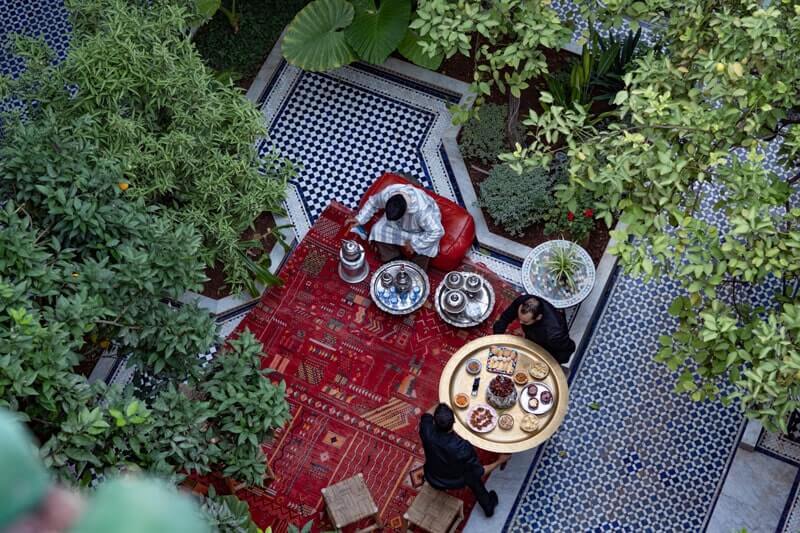To step into the 9,500 narrow alleys – or derbs – of Fez’s labyrinthine Médina is to walk into the Middle Ages. Handcarts are the latest technology, donkeys and men are beasts of burden. In a terrain beyond mapping and GPS, getting lost is inevitable.
 Over 60,000 people live, shop and pray within this ochre settlement. They pray because the muezzin’s booming words remind them, five times a day, to wash before prayer. At the University of al-Qatawiyyin, the world’s oldest continuous higher education establishment, founded in 859, Muslim scholars pray particularly fervently. Visitors can enter its white filigree rooms and courtyards – carved so delicately and so patiently – but not it’s library, home to one holy tome dating back more than a millennium.
Over 60,000 people live, shop and pray within this ochre settlement. They pray because the muezzin’s booming words remind them, five times a day, to wash before prayer. At the University of al-Qatawiyyin, the world’s oldest continuous higher education establishment, founded in 859, Muslim scholars pray particularly fervently. Visitors can enter its white filigree rooms and courtyards – carved so delicately and so patiently – but not it’s library, home to one holy tome dating back more than a millennium.
Fez is Morocco’s second city, after the frenetic moped-whining capital of Marrakech, but Fez is undoubtedly the country’s gastronomic leader. Take a walking Foodie tour of the Medina, stopping to taste olives, sweets and fresh juices, visitors see Fez in action. Amongst the cube-sized shops, shelves stacked to the ceilings with coriander and saffron, they see how tradition seasons Morocco’s love of food. In this sun-baked arid terrain, Khilli’i, the art of preserving food – predating refrigeration – is still a prized skill.
 As the day unfolds, pools of light and shadows drifting through dried palm frond roofing, so does the Médina. In the breakfast quarter, whilst there may still be a chill in the morning air, bowls of thick garlicky soup and a hunk of bread are served for breakfast. As are sfenj Moroccan style donuts, fried in spicy oil with an egg cracked over the sizzling batter at the very last moment. Specialist lunch stalls – think tajines and kesra flatbreads – soon follow. But don’t think too much of fish. It’s a word not even mentioned once in the Quran. For centuries fish was a luxury in a city so distant from the ocean.
As the day unfolds, pools of light and shadows drifting through dried palm frond roofing, so does the Médina. In the breakfast quarter, whilst there may still be a chill in the morning air, bowls of thick garlicky soup and a hunk of bread are served for breakfast. As are sfenj Moroccan style donuts, fried in spicy oil with an egg cracked over the sizzling batter at the very last moment. Specialist lunch stalls – think tajines and kesra flatbreads – soon follow. But don’t think too much of fish. It’s a word not even mentioned once in the Quran. For centuries fish was a luxury in a city so distant from the ocean.
Open, all day, as it has been for over half a dusty century is Atay Bnaana’s blue-tiled tea-room, maximum capacity a squeezed eight. At 10 dirham per cup, around £1, Atay’s cuppa is the Grand Cru, maybe even the Bollinger of mint tea. Using a gleaming copper samovar, Atay brews up spoonfuls of sugar with a touch of Chinese tea. Then he adds leaves of absinthe, geranium, verbena, sage and plenty of mint. Whether tea-drinkers are seeking winter warmth or summer refreshment, walnut-skinned Atay, is a flamboyant figure. Sporting an extravagant cerise head-dress, he joins in with the Médina gossip, sometimes initiates it.
 In the Medina you can literally follow your nose to navigate. There’s the aroma of the bakeries – where women take loaves to be baked that they have kneaded in their own kitchens. The aroma of the tanneries is just as pungent as it has been since medieval times. Sniff out the occasional fish-seller or the spices souk too.
In the Medina you can literally follow your nose to navigate. There’s the aroma of the bakeries – where women take loaves to be baked that they have kneaded in their own kitchens. The aroma of the tanneries is just as pungent as it has been since medieval times. Sniff out the occasional fish-seller or the spices souk too.
So often wandering through markets and souks, without a reason to buy, is a frustrating experience when travelling. A Fez foodie tour can end with cooking a meal, at the Fez School of Cooking. Guided by their chef the novice chefs create a lunch in a roof kitchen surrounded by bougainvillea, geraniums, olive trees and roses and views of the mountains.
The Fez School of Cooking sits on top of the Palais Amani. It’s a luxurious 18-room family owned hotel, with a hammam, of carved plaster arches and cooling cedar shutters. After a 1928 earthquake, the riad had been restored with the then fashionable Art Deco flourishes.
 Surprisingly it’s a look that blends well with the original Arabian – Andalusian architecture. The original building dates back to the 17th century. Although the Palais seems big for just one family – who allegedly made their fortune trading with Manchester – back then it was thought shameful if a son ever left the family home. His wife, and subsequent children, just joined one huge family. Although historical detail is elusive, it is thought that the family probably traded cotton or sugar.
Surprisingly it’s a look that blends well with the original Arabian – Andalusian architecture. The original building dates back to the 17th century. Although the Palais seems big for just one family – who allegedly made their fortune trading with Manchester – back then it was thought shameful if a son ever left the family home. His wife, and subsequent children, just joined one huge family. Although historical detail is elusive, it is thought that the family probably traded cotton or sugar.
“Compliments to the chef”, says one diner as he enjoys a chicken tajine and smoked aubergine salad, that he had created in the Eden Restaurant. Even in the midday sun, shade from lemon, orange and pomegranate trees, along with a trickling fountain help the Eden Restaurant, live up to the paradisal promise of its name.
 The riad’s garden seems a world away – but is just 50 yards – from the chaos of the packed derbs and the cries of “Balek” (Watch out!) as yet another trader guides his laden handcart through the alleys.
The riad’s garden seems a world away – but is just 50 yards – from the chaos of the packed derbs and the cries of “Balek” (Watch out!) as yet another trader guides his laden handcart through the alleys.
More information
Fez Cooking School at Palais Amani
For guests staying at the Palais Amani, the transfer from Fez airport can be arranged.











